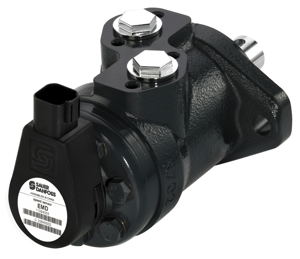Sauer-Danfoss claims that it has improved the control of hydraulic orbital motors using a new speed sensor that provides the highest speed resolution available, at the same time as indicating direction.
The patented, contact-free sensing mechanism follows the movement of a magnet inside a steel plug. A direct connection to the cardan shaft via a flexible axle means that it can detect even small rotational movements. A microcontroller in the sensor measures both the speed and direction of the magnet as it rotates – a task that previously needed two sensors.
The sensor’s high resolution avoids the need for external tacho generators, thus cutting costs.
“The new measuring principle means the EMD speed sensor can deliver very precise measurements,” says Sauer-Danfoss’ product marketing manager, Knud Meldgaard. “Pulse mode has 180 pulses per revolution as default setting, but can also be configured to a range between 20 and 120 pulses per revolution.”
Typical applications for hydraulic motors fitted with the new sensors will include forestry and road maintenance equipment. In forestry machinery, for example, where traditionally a quadrature signal is used to position tree-trunks for delimbing, the ability to measure both direction and speed will have benefits. In salt spreaders, the sensor’s high resolution will result in a more precise distribution of the salt.
The EMD speed sensor is available with standard output signals, which can be customised. It provides pulse and quadrature output signals as standard, with CANbus as an option. Up to 253 of the sensors can be connected to one CAN bus, thus saving on wiring and installation costs.

The sensor is designed for click-on mounting on the motor end-cover (as shown above). It is not in contact with the hydraulic oil, making field servicing easy. The shock-resistant and watertight (IP 69K) sensor has no corrodable parts and is designed to survive hostile environments.
